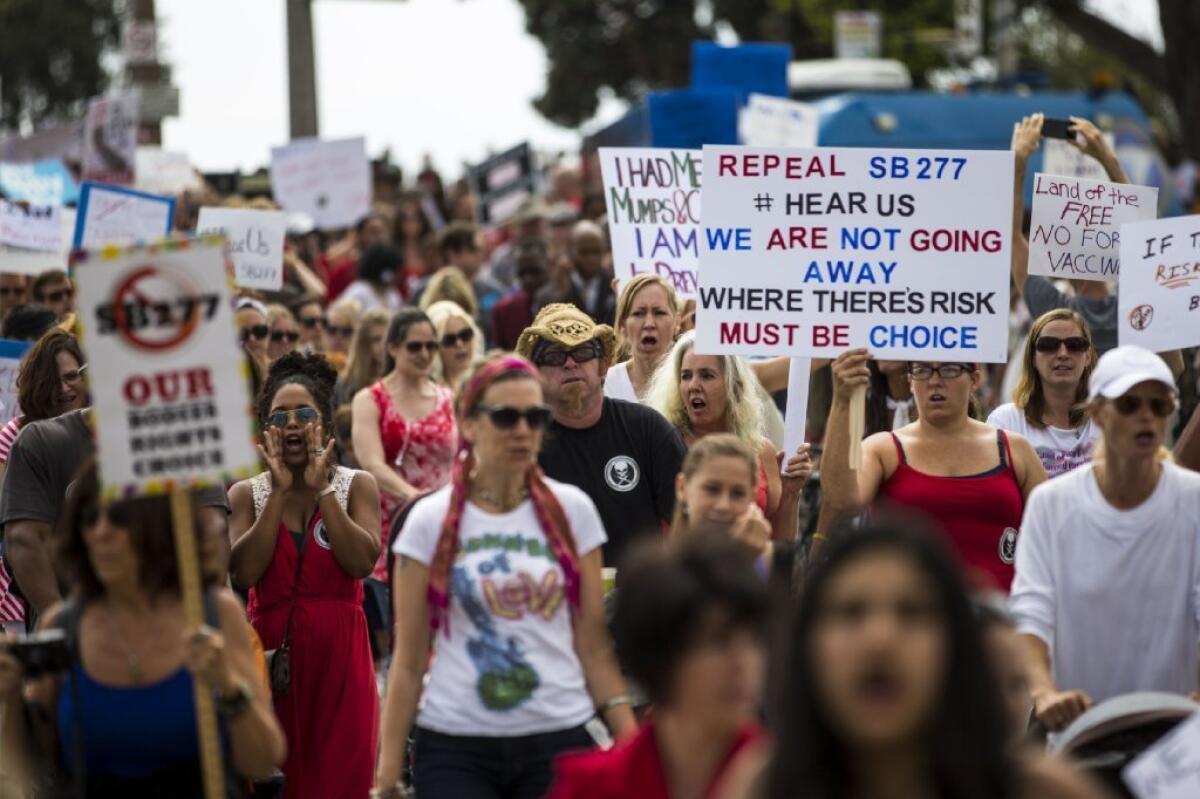Vaccination aversion has fueled measles and whooping cough outbreaks, study finds

The unvaccinated and undervaccinated have made up a majority of patients during measles outbreaks and a substantial minority of patients in pertussis outbreaks, a new study finds.
A comprehensive new study of measles and pertussis outbreaks in the United States suggests that adultsâ reluctance or refusal to vaccinate themselves and their children has played a key role in the resurgence of diseases that had been largely eradicated in this country.
In an analysis published Tuesday in the Journal of the American Medical Assn., epidemiologists scoured reports of measles and pertussis outbreaks to glean what role vaccination refusal and hesitance played. They also considered the effect of waning immunity among those who were vaccinated.
In measles outbreaks, the role of the unvaccinated was powerful, they found. Of 1,416 measles cases since the disease ceased to circulate in the United States in 2000, 57% were in people who had no history being vaccinated. About 70% of these patients were unvaccinated due to nonmedical exemptions.
Using the reports to draw a âcumulative epidemic curveâ â the trajectory of the infectionâs spread â the researchers found that unvaccinated individuals tended to be among the first few groups of people to contract the measles and pass them along. That suggests that unvaccinated people ignited many of the outbreaks â and were a key accelerant in their spread.
Measles can cause serious health problems, particularly in children under 5 and adults over 20. Inner ear infections, which can cause hearing loss, are not unusual. As many as 5% of children who get measles will develop pneumonia, and 1 in 1,000 will develop swelling in the brain, which can cause seizures and lead to deafness or intellectual disability. Death is a rare complication, but occurs in 1 or 2 children per 1,000 infected.
The researchers found a slightly different picture regarding outbreaks of pertussis, which is also known as whooping cough. Of the more than 10,000 cases that occur annually, outbreaks frequently occurred among the vaccinated â a sign that the DTaP vaccine (which protects against diphtheria, tetanus and pertussis) does not confer lasting immunity to all who get it.
Researchers reviewed 32 reports of pertussis outbreaks involving 10,069 patients whose vaccination status was known. Unvaccinated and undervaccinated individuals accounted for between 24% and 45% of the infected patients in five of the largest statewide epidemics in the analysis, including the 2010 and 2014 outbreaks in California.
In 8 of 12 pertussis outbreaks where vaccination data had been collected, between 59% and 93% of the unvaccinated patients who became ill were left unvaccinated for nonmedical reasons.
Pertussis is particularly dangerous for babies in their first year of life, with nearly half requiring hospitalization and 1% dying of the disease. About 5% of teens and adults who contract the disease require hospitalization, while 4% to 6% will lose consciousness from coughing or fracture a rib during a coughing spasm.
Dr. Matthew M. Davis, a pediatrician at the University of Michigan who wasnât involved in the study, noted that low levels of vaccination and waning vaccine immunity are distinct but related problems. When a growing slice of a given population declines to be vaccinated against a disease, the likelihood of an outbreak increases. At that point, people whose immunity has begun to wane can sustain the outbreak, he wrote in a commentary that was also published in JAMA.
If populations are to be protected adequately against vaccine-preventable diseases, Davis wrote, both problems must be addressed.
The researchers who conducted the comprehensive tally of outbreaks wrote that âthe risks of vaccine refusal remain imperfectly defined.â Those risks appear to vary for different diseases and in different populations, they added.
But if governmental bodies demand that parents vaccinate their children even if theyâre reluctant to do so, itâs important that the risks posed by vaccine refusers â to themselves and to others â be clear and well-documented, they wrote.
Public officials must also âaddress the reasons for vaccine hesitancy,â they wrote. Among those reasons, they noted, were âparental perceptions regarding the risk and severity of vaccine-preventable diseases, the safety and effectiveness of routine immunizations, and confidence in medical professionals, corporations, and the healthcare system.â
Follow me on Twitter @LATMelissaHealy and âlikeâ Los Angeles Times Science & Health on Facebook.
For more news on global sustainability, go to our Global Development Watch page: latimes.com/global-development
MORE SCIENCE NEWS
Does shark skin really reduce drag? Not so fast, study says
Opioids are bad medicine for chronic pain, say new federal guidelines
âMissing linkâ helps explain how T. rex became king of the dinosaurs




